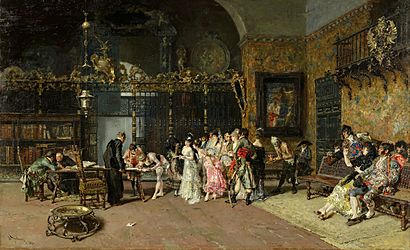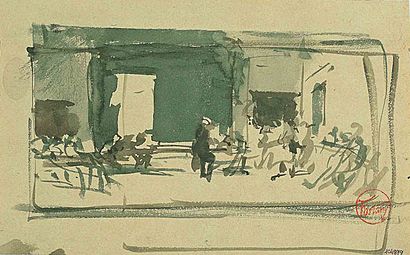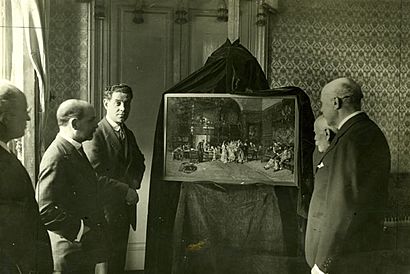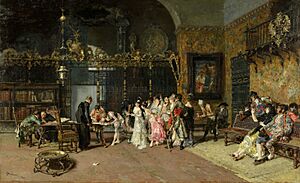The Spanish Wedding facts for kids
Quick facts for kids The Spanish Wedding |
|
|---|---|
 |
|
| Artist | Marià Fortuny |
| Year | 1870 |
| Medium | Oil on panel |
| Subject | Realism |
| Dimensions | 60 cm × 93.5 cm (24 in × 36.8 in) |
| Location | Museu Nacional d'Art de Catalunya, Barcelona |
The Spanish Wedding or La Vicaría (1868–1870) is a famous painting by Marià Fortuny. It shows a lively scene from a wedding. This painting is a great example of genre painting from the 1800s. Fortuny used bright colors and strong contrasts between light and shadow. This shows how talented he was as an artist. You can see this amazing artwork at the Museu Nacional d'Art de Catalunya in Barcelona, Spain.
Contents
Marià Fortuny: The Artist
Marià Fortuny (1838–1874) was an important artist from Catalonia and Spain. He was well-known in the 1800s for his oil paintings, etchings, and watercolors. Fortuny was a master of genre painting. This type of art shows scenes from everyday life. The people in these paintings can be from any social group. They can also include historical details.
Fortuny was a very gifted artist from a young age. He had already completed other great works by the time he was 12 years old. He finished The Spanish Wedding when he was just 32. This painting is a perfect example of the genre style in three ways:
- First, a wedding is a common part of life. Weddings were very important celebrations in Spain and Catalonia during the 1800s.
- Second, the painting tells a story all by itself. You don't need extra information to understand what is happening.
- Finally, it mixes old historical elements with things from his own time. This was typical for genre paintings.
The Story Behind the Painting
| Watercolor Sketch for "The Spanish Wedding" | |
|---|---|
 |
|
| Artist | Marià Fortuny |
| Year | 1868–1870 |
| Type | Watercolor on paper |
| Location | Museu Nacional d'Art de Catalunya |
Fortuny painted The Spanish Wedding between 1868 and 1870. He started it in Rome and finished it after moving to Paris. Fortuny was known for doing a lot of research before he painted. Many practice sketches and watercolors still exist today. These show how he worked on his art. Each sketch became more detailed. He would refine his ideas before painting on the main panel.
Fortuny often used his family and friends as models. He also hired professional models. For The Spanish Wedding, his wife, Cecilia de Madrazo, and her sister, Isabel de Madrazo, posed for him. Their father, Federico de Madrazo, was the director of the Museo del Prado. The artist Jean-Louis-Ernest Meissonier also modeled for the painting.
How the Painting Became Famous
It is thought that The Spanish Wedding was inspired by a visit to a church in Madrid. Fortuny visited this church while preparing for his own marriage to Cecilia de Madrazo. When the painting was shown in 1870, people all over the world loved it. Both the public and art experts praised it.
Instead of being shown at the famous Paris Salon, the painting was displayed at a gallery. This gallery belonged to Adolph Goupil in Paris. Goupil was a very important art dealer in the 1800s. The Spanish Wedding was quickly sold to Adèle Cassin for 70,000 francs. This was one of the highest prices ever paid for a painting at that time. Only Meissonier's 1814, la Campagne de France had sold for more in 1866. The Spanish Wedding made Fortuny internationally famous. His paintings were in high demand for the rest of his life.
The Painting's Journey to the Museum
| Showing "The Spanish Wedding", 1922 | |
|---|---|
 |
|
| Year | 1922 |
| Type | Photograph |
| Location | Museu Nacional d'Art de Catalunya |
The painting stayed with private owners until 1922. At that time, the Municipal Museum of Barcelona and the Museum Board of Barcelona bought it. There was a misunderstanding that made it urgent for the museum to buy the painting. People thought the owner was moving to America and taking the painting with him. The Barcelona government decided it was important for the artwork to return to Spain. Money for the purchase was raised by many people contributing. The painting arrived at the museum in 1922. Today, it is cared for and displayed by the Museu Nacional d'Art de Catalunya in Barcelona.
See also
 In Spanish: La vicaría para niños
In Spanish: La vicaría para niños


